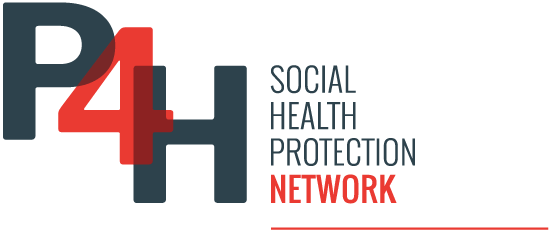On April 02, 2020, the Health Financing Team of WHO shared views on Priorities for the Health Financing Response to COVID-19 that reflected collective effort and thinking of WHO’s health financing experts working in WHO’s Headquarters and Regional Offices. This collective product was translated into Russian by the Center for Healthcare Quality Assessment and Control of the Ministry of Health, Russia, which is a P4H member organization.
Priority health financing challenges to combat COVID-19
Currently, the COVID-19 pandemic has affected every country in the world. Clearly, this requires immediate action, but also consistent and concerted action, as hasty and ill-considered action can lead to chaos and panic in individual countries and in the global community as a whole. In order to avoid this situation, it is necessary to distinguish between the objectives aimed at organizing, financing and delivering health care and the objectives to be achieved in terms of health security and Universal Health Coverage (UHC). However, the choice is not between health security and UHC, as in both cases investment in the basic elements of the health system, complemented by government action beyond the health system, plays a key role.
Compiled by the Health Financing Team at WHO Headquarters and Regional Offices.
The current priority is to plan, organize and restructure the health care delivery process to address urgent primary care needs. Health financing measures can facilitate a rapid and organized response to a pandemic. In particular, they should increase the delivery of health care and the provision of appropriate types of care at both the population and individual level. This requires ensuring that the two main objectives of health financing are achieved simultaneously:
Ensuring adequate funding for the procurement of universal health-care products, i.e. necessary for the delivery of health services at the population level, to provide an integrated surveillance system (including laboratories), health information systems and data recording and analysis systems, regulatory systems, and communication and information campaigns. Funding for such goods (Common Goods for Health (CGH) helps ensure public health system preparedness in times of crisis. Unfortunately, in many countries, preparedness for such situations has not been a major priority for States in recent years or even at the onset of the epidemic. However, there are solutions to correct the mistakes made and strengthen the system to combat COVID-19 now, making us more prepared now and for subsequent challenges in the future.
Eliminating financial barriers to health care delivery to ensure timely diagnosis and treatment of COVID-19 for all those in need. It is very important that people realize the extent of the problem and follow the recommendations of health authorities when and where to seek medical help. Concerns about the availability of health care for individuals and populations should not be a factor in decisions to seek care, especially during a pandemic.
Below are the main measures in the field of health care financing, the implementation of which will allow to achieve the stated goals.
1. Increase public funding for the health care system, including sponsorship funding where applicable. This will require action on budget planning and public financial management (PFM) to expand and reprioritize budget funding to combat COVID-19, as well as on processes to coordinate, ensure complementarity and align funding (public and sponsorship), which should affect ministries of health and finance, foundations, insurance organizations, regional governments and any other health service procurement agencies (e.g. national/agency
a) Increasing the priority of funding for the fight against COVID-19 for the entire health sector within the overall state budget, which is linked to the mobilization of internal public and sponsorship funds for the necessary measures. This may be associated with a substantial increase in measures to address COVID-19 in the first phase of the crisis, and may then be formalized by legislation.
b) Operational reallocation of funds to ensure timely, stable and sustainable funding for CGH. While additional funding alone does not provide adequate public health and surveillance system measures, contact tracing, water supply and disinfection, public health communication, testing and laboratory equipment supply are also critical and require adequate funding. Constraints preventing adequate funding should be removed as soon as possible.
c) Budget reallocation to ensure that the health system can adequately respond to the expected increase in demand for health and personal support services. In addition, the need for additional resources to facilitate access to testing and treatment for people living in remote regions and to pay overtime hours to health care workers should be considered.
d) Development of a special budget program to combat COVID-19 in order to facilitate monitoring of the effectiveness of measures and expenditures.
e) Giving essential service providers more flexibility and greater authority to respond immediately to shortages or shortages of essential supplies (e.g., soap, materials, medicines).
g) Ensuring transparent accountability mechanisms for the utilization of funds at all levels.
h) Engaging sponsors in the dialogue will help reduce the funding gap of national COVID-19 programs and align them with internal PFM mechanisms.
2. Regulate health care financing policies to remove regulatory barriers to care by providing free health care for the duration of the situation. In addition to pandemic-focused service delivery strategies, the implementation of population-based co-payments in payment for medical services, home health care, and teleconsultation should be suspended where it exists and is regulated.
Such a measure is not intended to encourage everyone to come to medical facilities, but rather to eliminate financial considerations as a factor affecting access to medical care. As practice has shown, payments for medical services are not a deterrent to seeking “unnecessary” medical care, but reduce the indicators of its availability, especially among the poor. If people assume or are unsure whether they will have to pay for a health care service, they may delay or avoid seeking health care altogether, making it more difficult to control the pandemic and putting the entire community at risk. Thus, people in need of treatment or in quarantine and isolation should not have to pay for medical services, including for treatment of comorbidities, because the thought of paying for services, even non-COVID-19 services, can be a factor in limiting people from seeking needed medical care.
However, a mere declaration of free health services is not enough, especially in countries where informal payments (e.g. for medical supplies or directly to health workers) for supposedly free services have become everyday realities for the population. Another issue is reimbursement for high transportation costs or other barriers to access to care.
a) Suspend all co-payments (fee for service) for all patients, regardless of insurance type, citizenship, or residency, for services in nursing facilities, home care, and for services during quarantine or isolation. These measures also need to be regulated as soon as possible and communicated to the public in a clear and timely manner.
b) Compensate health care providers for the loss of co-payment revenue as part of the overall public funding measures described above to enable providers to cope with increased demand. As part of the measures to increase state funding (consistent with (e) and (g) above), give agency heads more authority over the use of these funds, balancing this increased flexibility with transparent reporting requirements. Additional incentives for health care workers should also be considered.
c) Develop or simplify protocols to integrate and contract with private vendors, including appropriate payment methods, fees, and information reporting requirements.
d) Providing advance payments to public and private suppliers to cope with the expected increase in demand. This can be accomplished through advance payments or through “pre-funding” that would otherwise be subject to retrospective reimbursement.
g) Adapt payment models and pricing systems to reinforce the effectiveness of changes in locations and modes of health care delivery for the duration of COVID-19, including for home care, teleconsultation and other eHealth modalities.
h) Consider multi-purpose cash transfers to citizens, especially those more difficult to reach with existing COVID-19 measures, such as refugees, IDPs, migrants and the homeless. And it’s possible to realize this through digital platforms. Remittances may be particularly needed in poorer regions of the country and in fragile and conflict-affected settings such as refugee camps. All of these measures will allow people to stay in their homes as long as needed, get food and other necessities, while reducing indirect health care costs, including transportation costs and loss of income due to reduced work hours. The implementation of cash transfers will sometimes require a targeted social protection system in cooperation with the relevant authorities (e.g. ministry or social protection agency).
Thus, the mechanisms for financing the health care system, should be quickly adapted to the current conditions. It is necessary to prepare for the post-crisis period when the population begins to seek services that could not be provided during the peak of the COVID-19 epidemic. Most importantly, financing mechanisms must be simplified and streamlined, and the population must be clearly informed about rights and the best ways to seek health care. The actions outlined in this document provide a roadmap for measures of service change and expansion and will provide a solid foundation for establishing health care financing mechanisms to optimally provide and sustain health care and UHC security in the future.
This project was developed through the collective efforts of the WHO Health Financing Unit at headquarters and regional offices in Africa, the Americas, the Eastern Mediterranean, Europe, South-East Asia and the Western Pacific. Joseph Kucin, Susan Sparks, Agnes Soukat, Helen Barroy, Matthew Jowett, Camilo Seed, Peter Cowley, Jonathan Silus, Valeria de Oliveira Cruz, Fahdi Dhimi, Alexandra Earle participated, Tamas Evetovits, Xiu Kea Asha, Swa Ke, Ava, Ava Bruno Messen, Diane Muhongerwa, Juliette Nabionga, Claudia Pessetto, Thomas Rubal, Sarah Thomson, Tsolmongerel Tsilaazhav, Prosper Tumusiime and Hui Wang.


